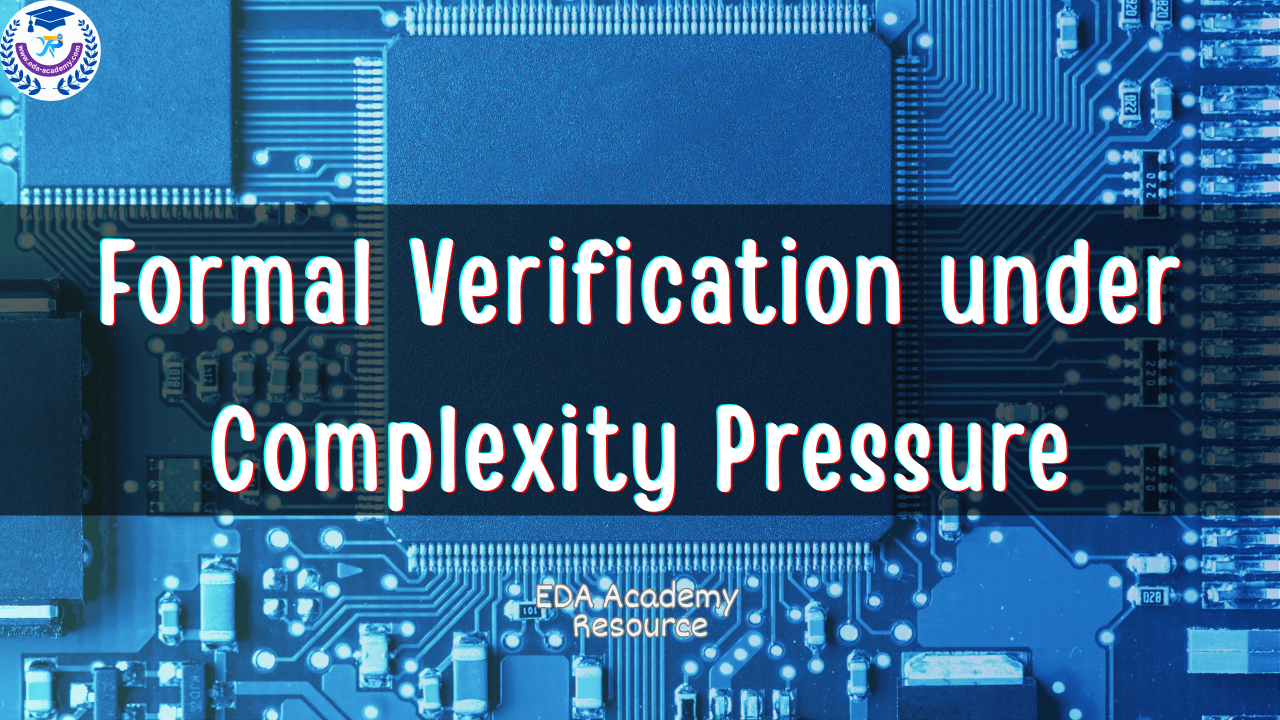Resource:
Formal Verification under Complexity Pressure (English)
Formal verification under complexity pressure requires scalable methodologies that move beyond exhaustive proof attempts. When full proofs are limited by state space explosion, deep logic cones, or long timing paths, alternative strategies become essential. This includes environment constraint refinement, modular partitioning, blackboxing, helper assertions, and symbolic input reduction. Property diameter and bounded proof depth offer practical means to guide tool settings and manage capacity. Over-constraining, initial state abstraction, and targeted bug hunting further improve convergence. The combined use of proof, coverage, and bug detection methodologies ensures a structured and coverage-driven approach to achieve formal sign-off even in complex SoC designs.
Purchase
Our course syllabus is regularly updated to reflect the latest advancements and best practices in the field. For individually purchased courses or resources with lifetime access, students can always access the content and receive updates for free. For members, all member-free courses and resources — including future updates — are accessible during the active subscription period. This ensures that both lifetime purchasers and active members can benefit from the most relevant and up-to-date content.
Created by EDA Academy
English
Last updated July 2025

Resource: Formal Verification under Complexity Pressure (English)
USD $199.9
-55%Today
$89.9
One-time Purchase
& Lifetime Access
What you will get:
1.3 Hours of Immersive, High-Quality Video Lessons
Professionally produced and delivered by our expert team, covering core concepts and practical demonstrations, with step-by-step explanations and real-life examples to help you efficiently absorb knowledge and apply it immediately in a short time.
Certificate of completion
Upon successful completion of the course, you will receive an official certificate issued by EDA Academy, adding value to your resume and career development.
Access on mobile and computer
The course can be viewed anytime on mobile phones, tablets, and computers, allowing you to learn easily whether at the office, at home, or on the go.
Ongoing support from EDA Academy
After the course ends, you will continue to receive ongoing support from our team to help you consolidate knowledge and solve practical problems.
Further learning plan
Provides you with follow-up learning paths and recommended resources, enabling you to continue improving your skills and expanding your career development based on what you have learned.
Resource Catalogue
Description
Modern formal verification faces increasing complexity due to deep control logic, wide data paths, and large register-transfer level (RTL) designs. As symbolic state spaces grow exponentially with design size and depth, full proofs become harder to achieve. Cones of influence (COI) expand with every added feature, and formal solvers are pushed to their memory and time limits. Temporal properties with wide conditional branches, long latency paths, or complex data dependencies introduce additional computational challenges. Key contributors to this complexity include fan-in depth, property diameter, and symbolic variability in input stimuli. Managing these factors is essential to maintain solver performance and proof convergence.
To address this challenge, formal verification applies a range of reduction and abstraction techniques across three core domains: environment, assertion, and design. Environment simplification focuses on reducing symbolic input space using tighter constraints, abstract drivers, or protocol limiters. By limiting non-determinism in input behavior, the formal engine explores fewer state transitions. Assertion domain reduction targets structural complexity by partitioning logic, rewriting temporal properties, or exposing intermediate signal values with helper assertions. These techniques guide solver search and reduce the number of logic levels that must be traversed per proof attempt.
Design-level abstraction plays a critical role in focusing formal analysis on meaningful logic regions. Partitioning the design into smaller formal blocks, blackboxing non-relevant modules, or trimming unused parameters helps narrow the proof target while maintaining functional intent. Logic modeling is often replaced with behavioral approximations, ensuring that verification remains conservative but tractable. Initial value abstraction removes complexity in reset and initialization sequences, especially in designs where memory or FIFO behavior depends on unknown starting states. These abstractions retain essential behavior while accelerating convergence.
Verification methodology adapts based on property classification and proof difficulty. The property diameter metric estimates required search depth and allows dynamic adjustment of solver bounds. Bounded proofs, when applied with temporal or structural limits, enable high-throughput convergence of proofs that would otherwise fail on depth or capacity. In areas where full proof is unattainable, over-constraining provides a safe and conservative limit to isolate analysis. Bug hunting strategies leverage partial proofs and symbolic simulation to detect counterexamples without solving the entire state space, accelerating feedback in regression and exploratory phases.
A structured sign-off process integrates formal proof, coverage metrics, and bug detection workflows. Full-prove methodology focuses on small, fully-verifiable modules or properties with finite logic depth. Coverage-driven methodology balances formal proof with coverage closure, tracking uncovered properties and incrementally expanding testbench constraints. Metrics such as proof convergence, bounded depth, and endpoint observation provide quantitative targets for quality sign-off. Comparison between formal verification flows—control-data verification (CDV), full-prove, and coverage—enables tailored strategy selection depending on design constraints and verification goals. When combined, these techniques enable systematic scaling of formal analysis across complex digital systems, ensuring both completeness and efficiency in high-assurance sign-off environments.
We HATE spam. Your email address is 100% secure
The document will be emailed to you. Please check your Spam folder if it doesn’t appear in your inbox.
We HATE spam. Your email address is 100% secure
